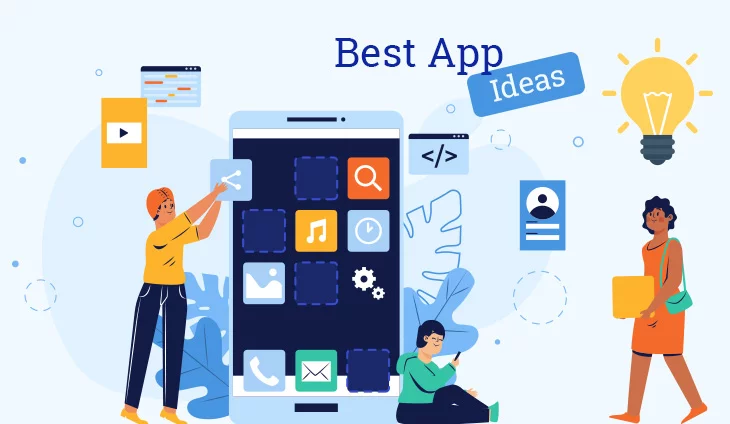5 resources to create your app idea

Thinking of creating an app? You are in good company. The mobile app industry is expected to be worth over $407 billion (yes, with a B) by 2026. Fortunately, there are plenty of resources to get you started, including this guide. Below, I’ll walk you through how to develop your app idea and then share five resources to help you get your app off the ground.
How to create your app idea
Like any business, building an application requires laying the groundwork before launching. Here’s a five-step guide to getting ready to launch your application, including how to do your research, how to monetize your app, and what to include in your business plan.
Create an app Step 1: Do market research.
Before building your application, you should first get familiar with the terrain. Who is your target audience? What other apps offer similar functionality or functionality? How does your application stand out?
Start by creating a buyer personalization card to help you understand who your audience is and what they want. Use this information to create a detailed sales plan, decide which features to include, and choose where to market your application.
Next, conduct a competitive analysis to understand your competition. The information you gain will be essential to create and develop your application. Focus on what current applications work well and what doesn’t. The areas where they fail can offer you opportunities to improve and win back some of your markets.
For example, if your goal is to create an application that offers exercise and diet recommendations, take the time to download similar apps and read their reviews. What features are users asking for, and what features don’t they like? Who uses these apps? How are they monetized?
Be thorough – you’ll use this information in the next steps.
Create an app Step 2 – Decide how to monetize your app.
The right choice for your application likely depends on your industry, target audience, and the type of application you’re building. For example, games are often monetized through ads and in-app purchases, while dating apps typically charge a monthly subscription fee.
Consider each of the following monetization methods to decide which one is right for your app:
- In-app purchase: Provide a free application and allow users to purchase add-ons as Pokemon Go does.
- Freemium: Give users access to a limited plan for free, then charge them to access all the features, as the Mindfulness meditation application does.
- Single payment: Charge a single fee to access the application. Remember that you won’t get a continuous revenue stream from updates, redesigns, and marketing.
- Monthly Subscription: Charge a small fee each month to access the application. This helps you maintain a steady income stream, making it easy to pay salaries and spend on marketing.
Many apps use multiple monetization methods. For example, you can offer a limited free plan and then charge a monthly subscription fee to access all the features. You can even use ads to monetize the free plan and offer a paid plan with no ads.
Some users may be annoyed with too many ads or hate paying for subscription services.
Find out what other apps in your industry are doing, but don’t be afraid to break the mold by trying a different approach.
Create an app Step 3: Create a business plan.
Most people assume that building an application is all about coding, but the real work begins long before you create your first line of code (or before you start building it if you’re using a builder); Application).
Once you’ve met your audience and decided how to monetize your application, take the time to create a business plan. This plan should guide your first few years in business and keep you stuck with the main focus of your application.
According to the Small Business Administration, your business plan must include:
- Summary: A brief overview of your business, what you will offer, and basic information about your leadership team, location, and growth plans.
- Company Overview: A step-by-step guide covering the problem your business will solve, the people your application will serve, and the competitive advantages your application offers.
- Market Analysis: A summary of your market research covering your app’s strengths, the trends you’re capitalizing on, and how your application compares to others in the same industry.
- Structure and Management: An explanation of who is responsible for your business and how your business is structured. Are you creating a C corporation or LLC, or are you a sole proprietor? Please include a list of top executives, their CVs and resumes, and even a summary of the benefits each person brings.
- Offer: A description of what your application does and how it benefits customers. Include plans for filing patents or copyrights where applicable
- Marketing and Sales Plans: An overview of your marketing strategy and how it will adjust over time. Describe how you plan to attract and retain customers, the sales process, and the areas you will focus your marketing efforts on.
- Financial projections: Information about your costs, the money coming from, and potential benefits. The costs of building an application can be low (especially using the application tools we’ll cover in the next section), but you’ll still need money for things like letting go. 39; web hosting, paid ads, etc. Plan sales for the first year, five, and explain how you reached those numbers and where the funding will come from.
Create an app Step 4: Create the app.
Now that you’ve laid the foundation, it’s time to create your application. It may sound a bit overwhelming, but it doesn’t have to be.
Advantages:
- cheap (just cost your time)
- full control of features, coding platforms, etc.
The drawbacks:
- requires in-depth knowledge of coding
- length
Hire an app builder
Hiring an app builder can be expensive, but they can help you get the application to market faster than coding it yourself.
Advantages:
- throw faster
- no need to learn coding languages
The drawbacks:
- can be expensive
- less control over functionality
Use an app creation tool.
Remember how building a website required expensive software and in-depth coding skills? The application creation tools provide the same functionality for apps.
Advantages:
- probably cheaper than hiring someone to build your app
- get to market faster
The drawbacks:
- limited by app editor functionality
- they have to pay to use the most (although they are generally affordable)
Create an app Step 5: Launch and submit to app stores
Once you’ve created your app, you’ll need to test it before launching it. Get some friends to download the application and let you know what you think. Consider using a mobile UX testing tool to see how users navigate your app and make adjustments before launching it.
Next, you’ll need to submit your application to the app stores, where users will download it. The most popular app stores are the Apple App Store and Google Play. Follow this guide to submit your application to the App Store and this guide to submit it to Google Play.
Don’t forget to optimize the app’s SEO! Best SEO Specialist in Dubai will help you rank higher so that people will find your app.
5 resources to help you build your app
Building an app is easier than ever, thanks to the variety of application tools that help you build and launch a mobile app. However, it can be difficult to determine which one to use with so many options.
Let’s go over some of the best app tools so you can find the one that’s right for you.
iBuildApp
iBuildApp is a complete application builder that provides all the tools you need to build an app using its drag and drop functionality. Start with one of their 1,000+ templates, then drag and drop features to add videos, images, text, etc.
This tool is ideal for creating applications for e-commerce, education, healthcare, business, media, retail, and financial services stores. Brands like the US Navy, Whole Foods, SEGA, and Emory University used this tool.
AppMakr by Appy Pie
Want to build an application but don’t have coding experience? Appy Pie helps you create an app in just three steps and Best SEO Dubai Company can help you to rank your app on top results. Choose from over 100 features, including GPS, in-app purchases, offline features, and push notifications. They also offer analytics so you can measure the performance of the app.
You can use it to build apps for dating sites, customer rewards programs, chatbots, retail stores, restaurants, and more. They will even help you submit the app to the app stores.
Appy Pie is used by brands like The Home Depot, Southwest, and Nike.





